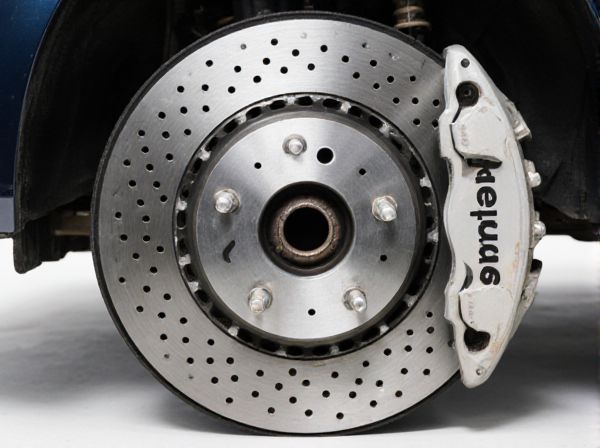
Photo illustration: Cross-drilled Rotor vs Dimpled Rotor
Cross-drilled rotors feature holes drilled through the rotor surface, enhancing heat dissipation and reducing brake fade during intense braking. Dimpled rotors have shallow, strategically placed dimples that improve water and gas evacuation, maintaining consistent braking performance in wet conditions. Choosing between them depends on your driving style and environmental needs, as cross-drilled rotors excel in high-performance scenarios while dimpled rotors offer reliable all-weather braking.
Table of Comparison
| Feature | Cross-drilled Rotor | Dimpled Rotor |
|---|---|---|
| Design | Multiple drilled holes across rotor surface | Shallow dimples stamped into rotor surface |
| Heat Dissipation | High - allows better air and gas flow | Moderate - improves airflow, less aggressive |
| Water & Debris Removal | Excellent - quick water evacuation | Effective - reduces water film but less than drilled |
| Brake Fade Resistance | Good - optimized for high-performance brakes | Moderate - enhances fade resistance |
| Structural Integrity | Lower - holes can cause cracking under stress | Higher - less prone to cracking |
| Noise & Vibration | Can produce noise and increased vibrations | Quieter operation with reduced vibrations |
| Durability | Moderate - wear faster due to stress points | High - longer lifespan due to intact surface |
| Best Use | High-performance and aggressive driving | Everyday driving with occasional spirited use |
Introduction to Cross-Drilled and Dimpled Rotors
Cross-drilled rotors feature holes drilled through the brake disc to enhance heat dissipation and reduce brake fade under heavy use, making them ideal for high-performance and track vehicles. Dimpled rotors have shallow indentations on the surface that promote better water and gas evacuation while maintaining structural integrity, improving braking consistency in wet and demanding conditions. Both rotor types optimize cooling and improve brake pad contact, but cross-drilled rotors prioritize maximum heat expulsion, whereas dimpled rotors balance heat management with enhanced durability.
Design Differences Between Cross-Drilled and Dimpled Rotors
Cross-drilled rotors feature multiple holes drilled through the rotor surface to improve heat dissipation and reduce brake fade by allowing gas and heat to escape more efficiently. Dimpled rotors, on the other hand, have shallow indentations that increase surface area and promote better cooling without compromising structural integrity. The primary design difference lies in the depth and shape of the perforations, with cross-drilled rotors offering active ventilation and dimples providing enhanced thermal management through increased airflow dynamics.
Heat Dissipation Efficiency
Cross-drilled rotors feature multiple holes drilled through the surface, enhancing heat dissipation by increasing airflow and reducing brake fade during intense braking. Dimpled rotors incorporate shallow indentations that improve heat dispersion while maintaining structural integrity and reducing the risk of cracking under stress. Both designs optimize cooling performance, but cross-drilled rotors are generally more effective in maximizing heat dissipation through improved ventilation channels.
Brake Performance Comparison
Cross-drilled rotors enhance heat dissipation by allowing gases and heat to escape through drilled holes, reducing brake fade during intense braking. Dimpled rotors improve water dispersion and maintain consistent friction by creating additional surface edges, which increases grip under wet conditions. Both rotor types optimize braking performance, but cross-drilled rotors excel in high-heat scenarios while dimpled rotors offer superior wet-weather braking stability.
Durability and Lifespan
Cross-drilled rotors feature holes that aid heat dissipation but can lead to stress fractures under high thermal cycling, reducing overall durability and lifespan. Dimpled rotors, with their surface indentations, maintain structural integrity better by minimizing stress points, resulting in enhanced durability and longer lifespan. For prolonged performance, dimpled rotors are generally preferred over cross-drilled due to superior resistance to cracking and wear.
Resistance to Brake Fade
Cross-drilled rotors feature drilled holes that enhance heat dissipation by allowing gases and heat to escape, reducing brake fade during intense braking. Dimpled rotors improve resistance to brake fade by increasing surface area and promoting better pad bite and heat dispersion without compromising rotor integrity. Both designs aim to maintain consistent braking performance under high temperatures, but dimpled rotors typically offer greater structural strength and longer lifespan under extreme conditions.
Noise, Vibration, and Comfort
Cross-drilled rotors offer improved heat dissipation and reduced brake fade, but they can generate higher noise and vibration levels due to the holes creating turbulence. Dimpled rotors provide a smoother braking experience with less noise and vibration, enhancing overall driving comfort by reducing brake judder. Both designs improve brake performance, but dimpled rotors prioritize noise and vibration reduction for a more comfortable ride.
Maintenance and Longevity
Cross-drilled rotors facilitate better heat dissipation and gas release during braking, reducing the risk of warping and extending rotor lifespan with proper maintenance. Dimpled rotors offer enhanced water and debris evacuation, minimizing corrosion and maintaining consistent brake performance over time. Both rotor types demand regular inspection and cleaning to prevent clogging and ensure optimal longevity.
Cost Analysis: Which is More Budget-Friendly?
Cross-drilled rotors typically have higher manufacturing costs due to the precision drilling process, making them more expensive than dimpled rotors. Dimpled rotors offer a more budget-friendly option by enhancing brake performance through surface modification without intensive machining. For cost-sensitive buyers seeking effective heat dissipation and improved braking, dimpled rotors provide an economical alternative to the pricier cross-drilled design.
Choosing the Right Rotor for Your Driving Needs
Cross-drilled rotors excel in high-performance and track driving by offering superior heat dissipation and enhanced brake cooling, reducing the risk of brake fade during aggressive braking. Dimpled rotors provide improved water and debris evacuation, making them ideal for wet or off-road conditions where consistent braking performance is crucial. Selecting the right rotor depends on your driving environment: opt for cross-drilled rotors for spirited or track-focused driving, while dimpled rotors suit everyday use in variable weather or off-road scenarios.
 caratoz.com
caratoz.com